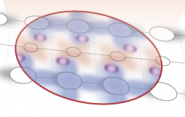Insights into the Metal-to-Insulator Transition

Metal-to-insulator transition - a process that turns materials from a conductor to an insulator - has been a crucial process behind microelectronic switches, nonvolatile memory, and neuromorphic computing materials. In many cases, this transition is accompanied by drastic changes in the electronic or structural symmetry of the material, which can bring about other unintended property changes to the material. It is therefore desired to realize such transition without breaking the symmetry of the materials.
 Prof. Yu He led a study, published in Physical Review Research, that brings a clearer focus on how these transitions can take place without breaking any symmetry in these materials.
Prof. Yu He led a study, published in Physical Review Research, that brings a clearer focus on how these transitions can take place without breaking any symmetry in these materials.
He and collaborators found that strong coupling between electrons and a vibrating atomic lattice can cause a metal to become an insulator without needing to disrupt the static lattice pattern. The finding reveals a new pathway to a transition that’s previously considered only inducible by strong electron-electron Coulomb interactions.
“Metal-to-insulator transition has been an enduring theme in condensed matter physics research because it often involves the electrons changing its own rules of organization between two fundamentally different states,” said He, assistant professor of applied physics. To “trick” the material into such a transition without incurring any disruption in its underlying symmetry, the key here is to exploit the massive fluctuations of the atomic positions when the material is quasi-one-dimensional.
“To put it in plain English, the material needs to have a chain-like crystal structure motif. That’s how we found the needle-like material Ta2NiSe5.”
Both electron-electron Coulomb interaction and electron-lattice coupling can give rise to metal-to-insulator transitions in the absence of any broken symmetry. But to pin down the dominant contribution, He says, it is also crucial to determine the effective interactions in each sector. ”Quantitative determination of the interaction parameters in the Schrodinger's equation of real materials has been a very difficult task.”
For their subject, He and his research team mounted a coordinated attack from both experimental and theoretical sides. Combining in situ angle-resolved photoemission spectroscopy and x-ray diffraction provided the researchers with a direct microscopic view of the material’s electronic and atomic behavior. Integrated with advanced model calculations in collaboration with Prof. Yao Wang and his team at Emory University, the researchers were able to directly generate an effective “digital representation” of the material that captures almost all of its unconventional physical properties, including the symmetry-preserving metal-to-insulator transition, induced by electron coupling to massive lattice fluctuations. In most bulk materials, the atoms are so heavy and sluggish that when they vibrate, the electrons - with less than 1/1000 of the atomic mass - can almost always instantaneously follow. This is the so-called Born-Oppenheimer approximation (“Yes, THE Oppenheimer,” He says).
“However, when the materials are quasi-one-dimensional, the atomic lattice often violently fluctuates, and sometimes the electrons can no longer keep up with every twist and turn the atoms make,” He said. “Then they throw their hands in the air and say ‘OK, I quit’. That’s when you get an insulator. But the atoms have yet to break any symmetry - they just oscillate around their original, static position.“
He notes that with the rapid development of advanced spectroscopy and modern computational methods, this work not only reveals low-dimensional fluctuations as a largely untapped source to engineer novel properties in quantum materials. It also offers a more general framework to “sequence the materials genome” by directly measuring the microscopic interactions strengths in minimal quantum many-body models of these materials.
“Once we have their quantum DNAs in hand, these complex materials will be a lot more tameable for predictive materials engineering,” He said.
The paper’s other authors are Cheng Chen, Xiang Chen, Weichen Tang, Zhenglu Li, Siqi Wang, Shuhan Ding, Zhibo Kang, Chris Jozwiak, Aaron Bostwick, Eli Rotenberg, Makoto Hashimoto, Donghui Lu, Jacob P. C. Ruff, Steven G. Louie, Robert J. Birgeneau, Yulin Chen, and Yao Wang. This work used public facilities offered through the US Department of Energy and the National Science Foundation.

